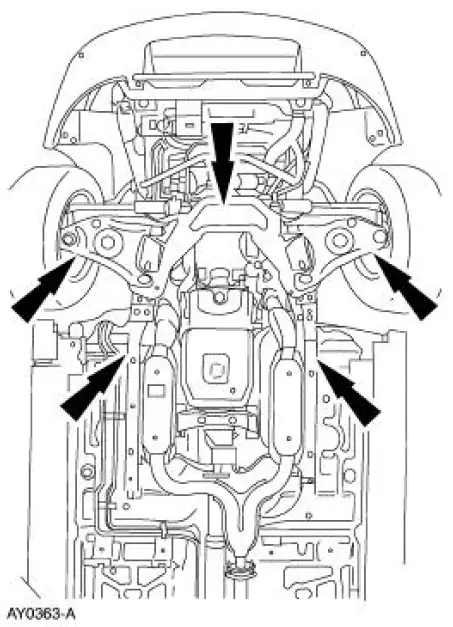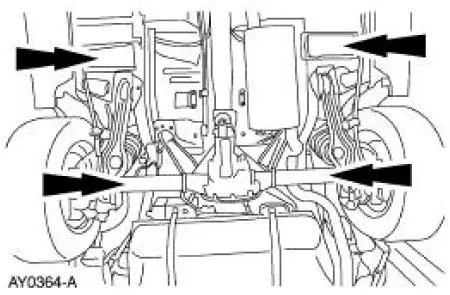Ford Mustang (1999-2004) Service Manual: Jacking
WARNING: Never run the engine with one wheel off the ground, such as when changing a tire. The wheel still on the ground could cause the vehicle to move.
CAUTION: The jack (17080) provided with the vehicle is intended to be used in an emergency for changing a deflated tire. To avoid damage to the vehicle, never use the jack to lift the vehicle for any other purpose. Refer to the Owner Guide when using the jack supplied with the vehicle.
CAUTION: Under no circumstances should the vehicle ever be lifted by the suspension arm brackets, rear stabilizer or differential housing or convertible cross brace. Severe damage to the vehicle could result.
CAUTION: Do not attempt to use jack pressure on either the front bumper (17757) or the rear bumper (17906) of any vehicle. Damage to the bumper covers will occur.
Lift the vehicle using the Jacking Points procedure in this section.
Jacking Points

To lift the front or either side of the front end, position the floor jack under the front frame lift points.

To lift the rear or either side of the rear end, position the floor jack under the rear lift points.
 Lifting
Lifting
CAUTION: Do not allow the lift adapters to contact the steering
linkage, suspension arms,
stabilizer arms, or to compress the lower suspension arm stabilizer bar
insulator (5493).
Damage to the sus ...
Other materials:
Connecting Rod - Bearing Journal Clearance
Special Tool(s)
Plastigage
303-D031 (D81L-6002-B) or
equivalent
NOTE: The crankshaft connecting rod journals must be within
specifications to check the connecting
rod bearing journal clearance.
1. Remove the connecting rod bearing cap.
2. ...
Transmission Drive Cycle Test
NOTE: Always drive the vehicle in a safe manner according to driving
conditions and obey all traffic
laws.
NOTE: The Transmission Drive Cycle Test must be followed exactly.
Malfunctions must occur four
times consecutively for shift error DTC code to be set, ...
Pump - CII
Special Tool(s)
Teflon Seal Replacer Set
211D027 (D90P-3517-A) or
equivalent
Removal and Installation
1. Disconnect the power steering hose. Remove and discard the seal ring.
2. Disconnect the power steering hose.
3. Remove the pulley.
...

